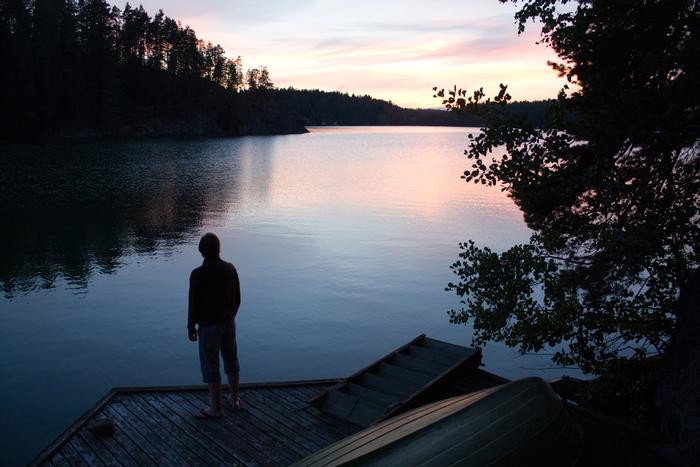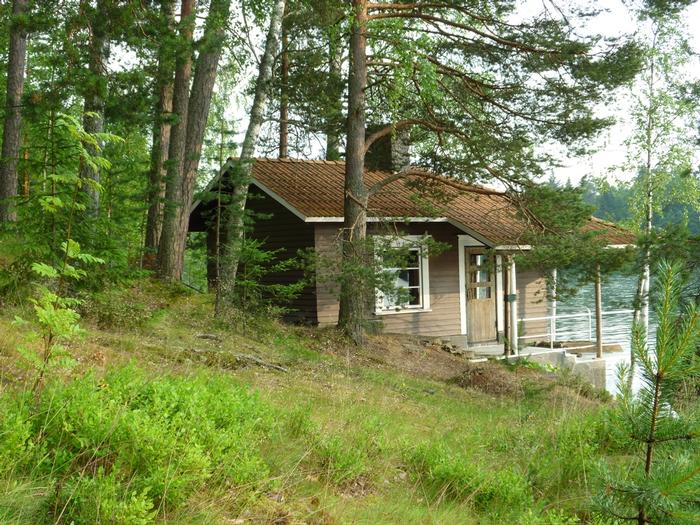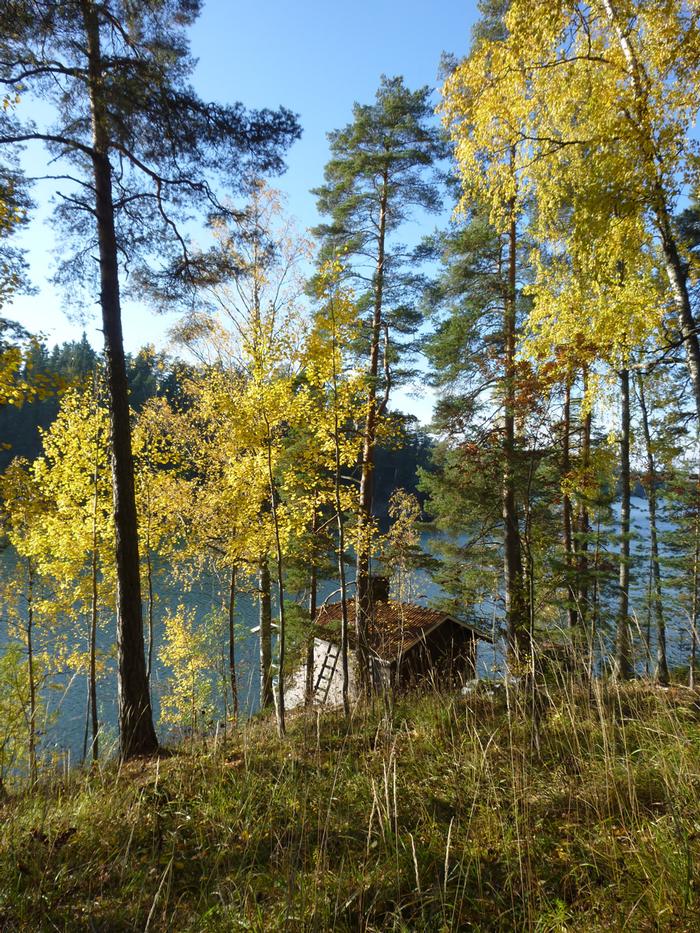[ID:74] Sauna: Temple of the Five SensesFinland “Our experience and sensibilities can evolve through reflective and silent analysis. To open ourselves to perception we must transcend the mundane urgency of “things to do”. We must try to access this inner life which reveals the luminous intensity of the world.” – Steven Holl
It is quiet. I am walking down a forested slope from the main cottage. A small wooden hut sits by a still lake. It is painted brown, with white window frames. Smoke is furling from a chimney. I enter the building through the weathered door and find myself in the dressing room, overlooking the lake. I am ready for sauna. This peaceful moment from my childhood, from the sauna of our family summerhouse, is embedded deep within my memories. It is not rare; in fact, there is nothing more traditional to a Finnish summer than going to sauna. The practice has long roots in the history of the nation. In the old times, sauna was associated with mystical and spiritual beliefs, and the place was also often considered sacred.
Despite the long history and continuing popularity, modern Finns rarely consider sauna as sacred. It is nowadays viewed as an everyday bathing place, where the original significance is forgotten. Yet I believe that the sacred qualities, developed through centuries of experience and wisdom, encompass important clues for understanding the universe and our existence, and should therefore be maintained. This essay aims to highlight and discuss the core elements of the sacred experience. It considers the sensual and thermal elements of bathing and compares them to the phenomenological theory of architecture. The aim is to discuss whether the lost sacred qualities of sauna can be re-kindled by emphasising the sensual experience, gained through bathing in the sauna.
The architecture of our family sauna is very simple; yet in this form the building seems perfect. The actual structure is small and rectangular, with a pitched roof. Moss grows on the roof tiles, making the building almost disappear in the landscape. The floor plan is the same as in almost every sauna in the country; next to the entry, there is a small dressing room, with a fireplace and chairs. From the dressing room, one enters the washing room, which includes a stove for heating the water. Built in the 1930s, there is neither shower nor running water in the building, and the water must be carried from the lake and heated in the stove. The actual sauna is a small room with wooden benches, held up by pillars, forming a raised structure of seats.
References in ancient folklore suggest that sauna was known long before the beginning of modern times in Finland. But as anthropologists know little about the history of Finns prior to the Middle Ages, the origin of sauna is in question. It is unknown whether Finns have always had a sweat bath, or whether sauna was developed after influences from other cultures. As being an effective and simple tool for personal hygiene, different forms of sweat bathing have been popular in many cultures around the world. Some archaeological finds suggest that sauna was known already in the Stone Age, 6000 years ago.
The first saunas were very primitive. Our ancestors simply dug a hole in the ground, covered it with a tarp and placed an open fire in the hole. The bathers would then wait until the fire had gone before entering this primitive sauna. This concept is very similar to the Native American sweat lodges and other primitive sweat bathing facilities around the world. The building type has then evolved with the development of the typical traditional Finnish houses, resulting in a log cabin built of walls of horizontal logs. When building technology evolved and Finns adopted larger houses, they often kept a small building separate, used specifically for the purpose of sauna.
The fire and steam of the sauna were a mysterious phenomenon for our ancestors and contained a wealth of spiritual meanings. Fire has always been a symbol of power, vigour, and vitality. As the rocks in the sauna could absorb the power of fire, they acquired spiritual significance to the early bathers. They believed that sauna was heaven sent and, if treated properly, it could drive off diseases and spiritual evils. However, if treated disrespectfully, fire could also destroy the bather.
When water was thrown on the rocks, the vapour became another medium for the transfer of heat and another object of worship. In Finland, this vapour was named löyly, which also meant spirit of life. The spiritual importance of sauna is largely to do with its association with re-birth. It has been said that the warm, dark, moist ambiance inside is easily likened to a womb, and by sitting in it and sweating out physical and spiritual impurities, one can emerge feeling like newborn.
Sauna was also a place to cure diseases. The smoke of the fire contained acids that would sterilise the surfaces. Therefore saunas were used for operations such as blood cupping and bloodletting. Women also gave birth in saunas in order to be close to the benevolent spirits, which were believed to reduce the pains and ensure the survival of both mother and child. When it was too long a journey to go to the hospital, women preferred to give birth in a sauna and bring a local midwife there. The custom continued until mid-20th century, especially in the countryside.
Rites of passage often took place in sauna. The bodies of the dead were taken there to be washed and prepared for their last journey before burial. According to H. J Viherjuuri, sauna also was a place for the worship of the dead, who were “supposed to return gladly, even after death, to so pleasant a place”. The sacredness of sauna was so evident that an old Finnish saying even tells the bathers to conduct themselves as one would in a church. It was forbidden to make a noise or to speak indecently, as all evil influences had been driven out.
The therapeutical effects of sauna have later been studied, and it has been proven that sweating and thermal extremities are very powerful tools to boost one’s immune system. In addition, the hot stones of the stove have been proven to release negative ions that give a pleasant, relaxed feeling. On the contrary, positive ions, released from structural materials and electrical appliances can be causes of anxiety in our lives. Therefore going to a sauna can also be very practical therapy from artificial substances in our modern world.
In a country of 5 million inhabitants, there are now 1,6 million saunas in Finland. Hence, one would assume that the sauna culture is well and alive. Yet, whilst the sauna experience is still very much present today, I believe that by having lost the connection to the ancient spirits and sacred experience of sauna, we have lost an important part of our heritage. The spiritual aspect has long been overlooked. Small electronic saunas, built in the bathrooms of small apartments, are very far from the original concept. People turn the sauna on by pressing a button; in order to sit in the heat of these cramped boxes, where everyday life looms just around the corner. The setting could not be further from that of a traditional sauna by a lake, surrounded by forests. The barrier between the sacred and the secular has been lost.
In my opinion, we would benefit from some mysticism, shadows and indigenous spirituality in the rational and secular world of today, reminding us of our existence and origins. By designing saunas in a right way, we could perhaps help people have a deeper, even spiritual experience there. In order to do that, however, we would be required to acknowledge the old beliefs and mysticism and to be able to interpret them in the modern world.
Architectural phenomenologists such as Juhani Pallasmaa and Steven Holl emphasize the importance of senses and existential experience in architecture. The phenomenological theory can be applied to sauna, as the experience of going to a sauna is dependent on senses other than vision. This represents a stark contrast to most other buildings, as architecture is usually seen as a visual syntax. The other sensory experiences have often been neglected in modern buildings, where sleek, flat surfaces and empty spaces are electronically maintained at a steady 21 degrees, year round. The tendency of modern building technology to standardise environmental conditions is impoverishing our environmental experience. Thus, buildings that speak to the other four senses have even more importance as reminders of our existence through our bodies.
The importance of phenomenological architecture lies also in fighting the hegemony of vision, which is more present than ever in today’s world. The ocularcentrism of our culture is therefore questioned and criticised. According to Juhani Pallasmaa, architecture now projects retinal images for the purpose of immediate persuasion, instead of creating existential microcosms, embodied representations of the world. These representations cannot be created if vision is the only sense used in the architectural experience. In Pallasmaa’s words, “our buildings have lost their opacity and depth, sensory invitation and discovery, mystery and shadow”.
The most obvious sensual experience of sauna is the change of thermal conditions; from the ice-cold winter air or freezing lake water to the moist heat of the sauna. Thermal qualities are an important part of our experience of a space, and have a great effect on how we feel about it. The cosy warmth of a sauna, together with the dancing and ambient light, smoky smell and crackling of the stove, create an immediately relaxing and strong atmosphere.
My most profound memories of sauna are from experiences through senses other than vision. I remember the hot slash of the humid heat when water was thrown on the stones. I also remember smelling the moist birch bundle, touching the coarse surface of the logs thrown in to the stove, or feeling the cold tingling on my feet when cooling off from the sauna outside.
Some nights spent at our family sauna can only be described purely magical. After bathing and swimming in the lake, we used to sit on the small terrace and watch the sun go down behind the trees on the opposite shore. Sometimes it was so quiet and the water was so still that it became a mirror, so that fish feeding on insects near the surface created large rings of water. At sunset, both water and sky were coloured purple, separated from each other only by the black silhouette of the forest. It was during these moments that I felt a magical feeling of happiness and peace; it was a beautiful moment when I knew that the world made sense and was so very beautiful. Even the course of time seemed to stop for a while. I felt in total harmony with my body, with nature and with the universe.
Bathing in the sauna led me to a strange, heightened experience of life at the moment, which Virginia Woolf calls a “moment of being”. Woolf asserts that these moments of being are flashes of awareness that reveal a pattern of something much larger, usually hidden behind the “cotton wool of daily life”. According to Woolf, most of our life is spent in moments of non-being. Amid them, a moment of being seems to be a shock of transcendence, where the self is lost entirely and subsumed into something larger: “I am hardly aware of myself, but only of the sensation. I am only the container of the feeling of ecstasy, of the feeling of rapture.” (Woolf, Sketch of the Past)
It may be hard to describe the experience of a moment of being, but it is even harder to purposefully reach it. Based on my experience, these moments happen only when one lets go totally, and becomes a silent observer. Perhaps the sensation is similar to the concept of mu in the Japanese zazen meditation. It is described that sometimes during the meditation, both mind and body “drop away”, thus revealing the essential nature of reality as mu – the formless potential beyond time and space that constantly manifests itself in the phenomenal world.
I believe that, although impossible to force, the moments of being, or the moments of “mu”, can be facilitated by great works of architecture. That, to me, is a true proof of sacred significance of a building, regardless of its official recognition. Separate from the purpose of use of a building, sacredness is manifested in the ability of a building or place to make us realise something about our existence. In my opinion, the sacred qualities of buildings found in our everyday environments can be even more powerful than churches or temples. These seemingly informal places and buildings like sauna do not require any specific religion, race or culture; instead, they reveal universal sacred experiences to everyone present.
Sacredness can also be seen as a way to communicate the extreme importance of a symbol to society, be it a building or another item. Acting as a repository of meanings, a symbol represents something considered essential to human experience. Therefore its preservation is extremely important, and by deeming it sacred, one ensures its survival through time. It is essential for the modern Finns to better understand the value of sauna as a symbol of their existence. In order to heighten this awareness, architects should pay attention to designing saunas that still bear a wealth of sensory experiences, and where the primitive mysteries of fire, water and nature are present. Traditional saunas from the old days should also be preserved and made more accessible for the public to use, in order for even the city-dwellers to regularly experience the wonder of primitive bathing.
In conclusion, bathing in a sauna can be an important way for us to better understand the universe and ourselves; it can indeed provide a sacred experience. By experiencing the sensual properties of sauna, we learn to live through all our five senses, and appreciate the much deeper insight into life that is gained by using them. The sensory experience also helps us to leave our busy minds for a moment and remember the true wonder and mystery of our existence. Because, ironically, the best way to gain a better understanding is to let go of worry and control, and to quietly surrender and become an observer. In the words of Finnish architect Marco Casagrande, ”One has to die a bit to be reborn. One will not get closer to nature by sitting in an air-conditioned office. The ultimate reason of nature is not to keep the air-conditioning on. Nature has one rule: existence maximum. Man has one identity: nature.”
If you would like to contact this author, please send a request to info@berkeleyprize.org. |




